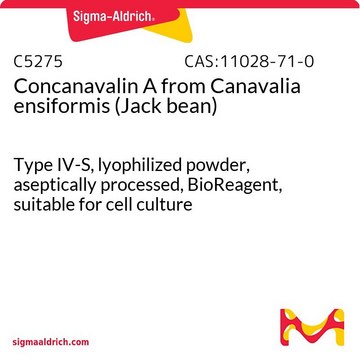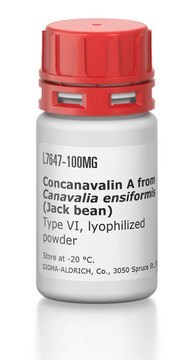C9017
Concanavalin A aus Canavalia ensiformis (Jack bean)
Sepharose™ conjugate, buffered aqueous suspension
Synonym(e):
ConA
About This Item
Empfohlene Produkte
Biologische Quelle
Canavalia ensiformis
Qualitätsniveau
Konjugat
Sepharose™ conjugate
Form
buffered aqueous suspension
Enthält
20% ethanol as preservative
Kennzeichnungsgrad
10-16 mg per mL
Matrix
Sepharose 4B
Matrixaktivierung
cyanogen bromide
Matrixanbindung
amino
Matrix-Spacer
1 atom
Kapazität
≥25 mg/mL binding capacity (thyroglobulin)
Lagertemp.
2-8°C
Suchen Sie nach ähnlichen Produkten? Aufrufen Leitfaden zum Produktvergleich
Anwendung
Biochem./physiol. Wirkung
Physikalische Form
Hinweis zur Analyse
Rechtliche Hinweise
Ähnliches Produkt
Signalwort
Danger
H-Sätze
Gefahreneinstufungen
Repr. 2 - Resp. Sens. 1 - Skin Sens. 1
Lagerklassenschlüssel
3 - Flammable liquids
WGK
WGK 3
Flammpunkt (°F)
102.2 °F
Flammpunkt (°C)
39 °C
Analysenzertifikate (COA)
Suchen Sie nach Analysenzertifikate (COA), indem Sie die Lot-/Chargennummer des Produkts eingeben. Lot- und Chargennummern sind auf dem Produktetikett hinter den Wörtern ‘Lot’ oder ‘Batch’ (Lot oder Charge) zu finden.
Besitzen Sie dieses Produkt bereits?
In der Dokumentenbibliothek finden Sie die Dokumentation zu den Produkten, die Sie kürzlich erworben haben.
Kunden haben sich ebenfalls angesehen
Unser Team von Wissenschaftlern verfügt über Erfahrung in allen Forschungsbereichen einschließlich Life Science, Materialwissenschaften, chemischer Synthese, Chromatographie, Analytik und vielen mehr..
Setzen Sie sich mit dem technischen Dienst in Verbindung.









